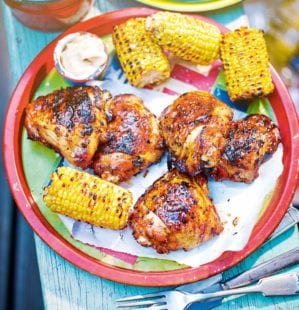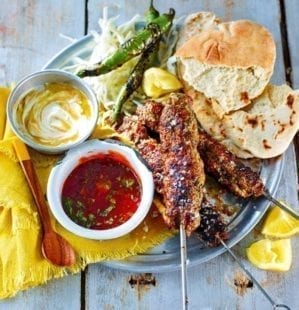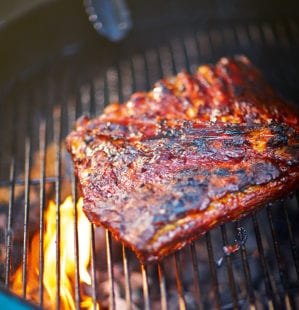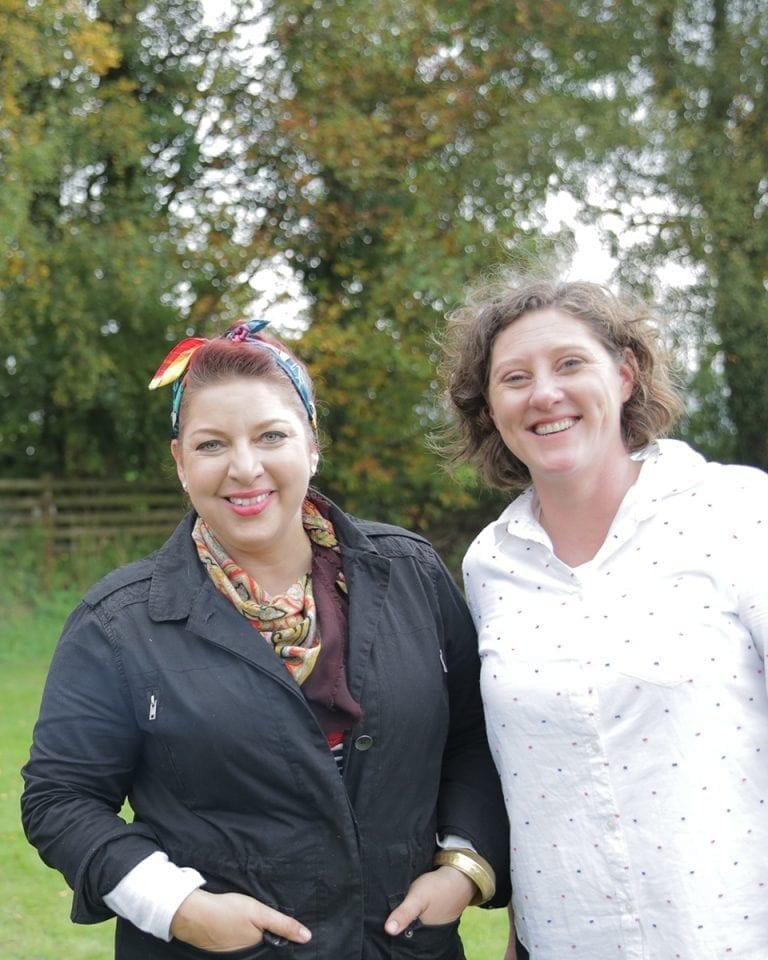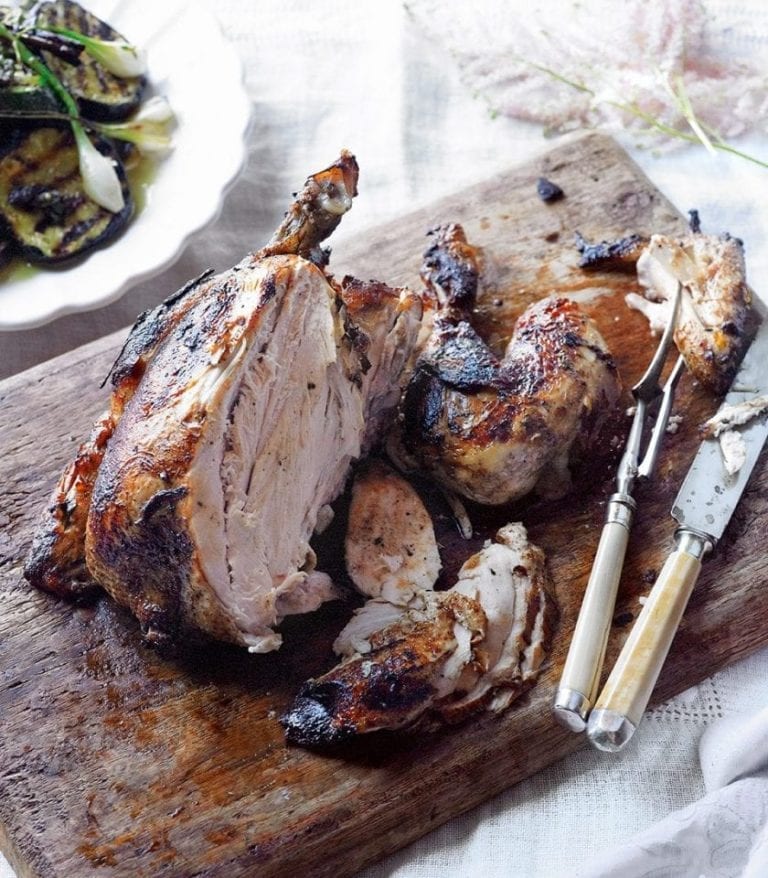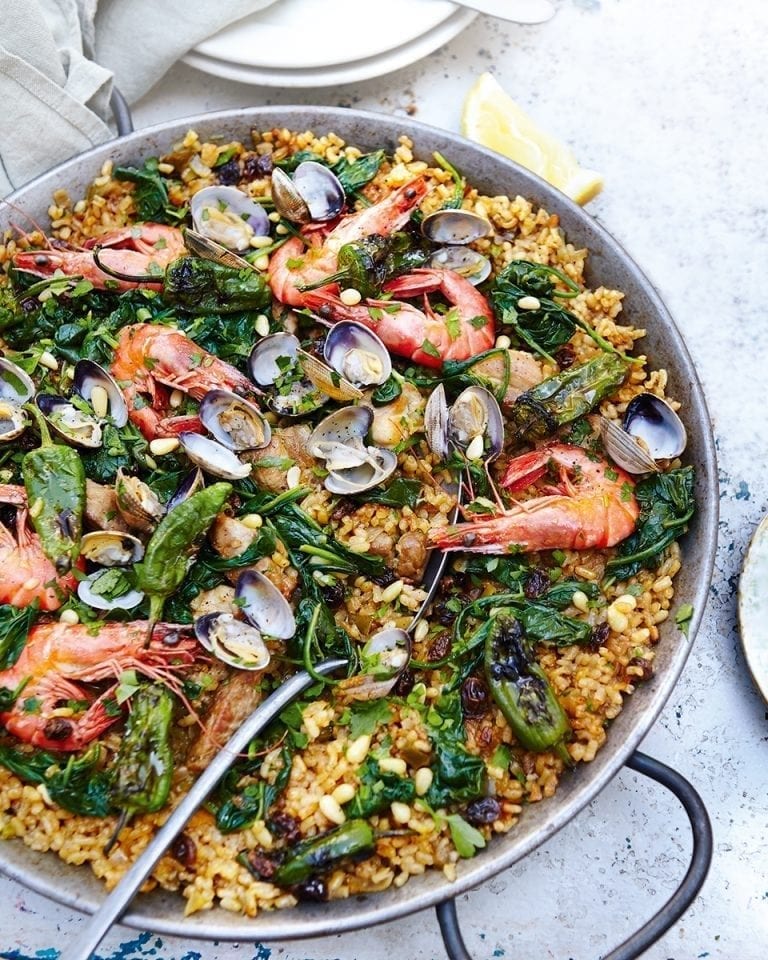Barbecuing hot tips
Don’t be afraid of your barbecue – just follow our easy dos and don’ts, be sensible, and go in for the grill! When you’re cooking on coals, even before you decide what food to grill, you need to get the barbecuing basics in order: good quality fuel, a foolproof lighting method and a bit of nouse when it comes to controlling the temperature.
Read on for our tips on how to light the barbecue, working with indirect or direct heat, and troubleshooting…
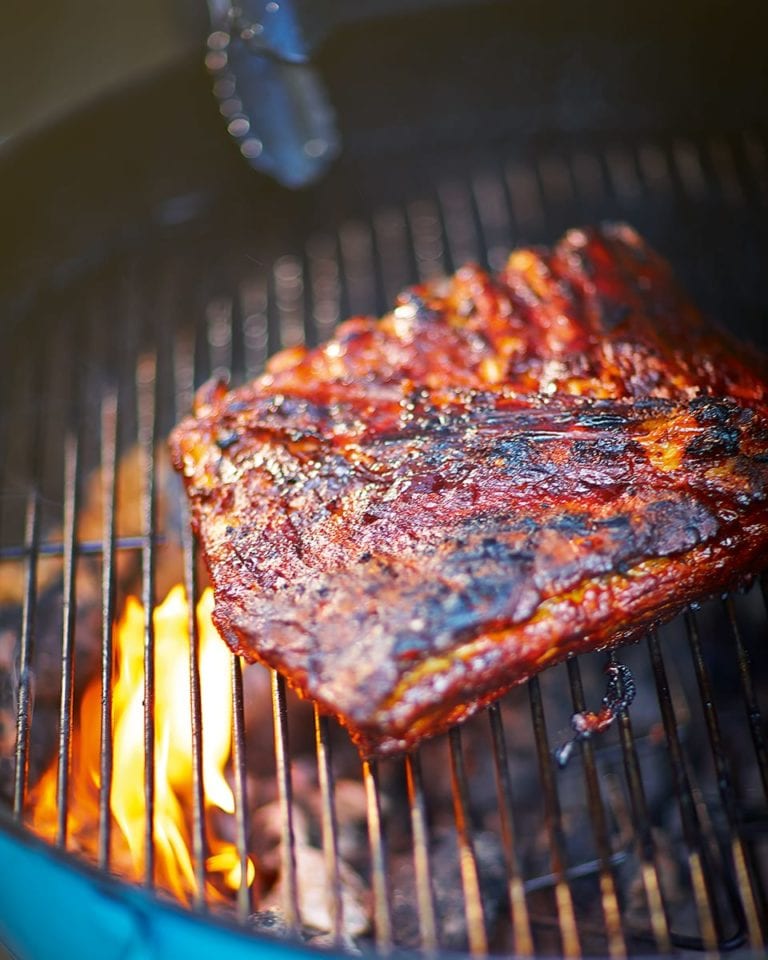
Lighting a charcoal barbecue
Unless you’re going all-out with a log fire, charcoal is likely to be your primary heat source. But not all coal is created equal…
‘Instant light’ coals are usually soaked in chemicals which, while useful for getting things going, can infuse anything that’s cooked above them with a petrol-like flavour if they haven’t burned off properly. Hone your fire-starting finesse and opt for lumpwood charcoal from sustainable sources. It burns at a high, consistent temperature that’s perfect for barbecuing.
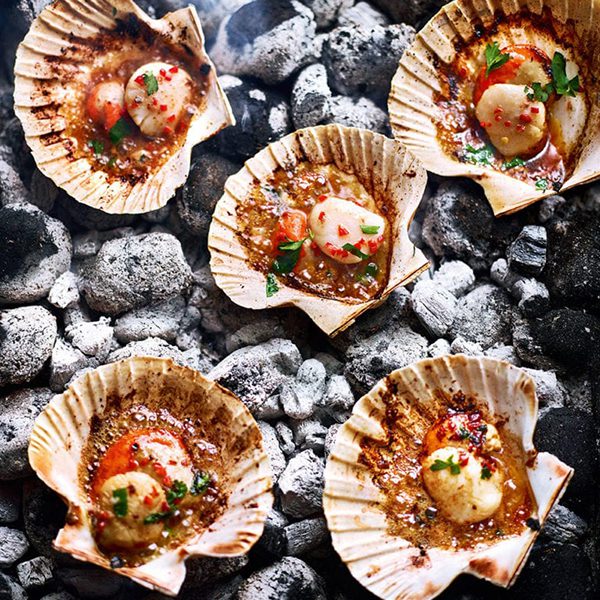
If you’re planning to do more low-and-slow cooking, briquettes (essentially compressed wood) burn more slowly, but tend to be tougher to light and are more likely to be infused with chemicals.
Starting the fire: the basics
-
- Remove lids or cooking grates and open air vents. Place a few firelighters (the shredded-wood, wax-dipped ones that look like bundles of straw rather than paraffin blocks) in the centre of your barbecue.
- Open your bag of charcoal and pick out some of the larger pieces. Using fire gloves or tongs, lay them on and around the firelighters, building a pyramid-like structure with plenty of gaps between the coals (a little like a campfire)
- Start adding smaller pieces of coal in the gaps created by the larger ones – but make sure you don’t close up the gaps completely (and leave yourself enough space to get a flame to your firelighters).
- Light the firelighters. Ensure any vents on your barbecue are fully open and the lid (if it has one) isn’t closed. Don’t be tempted to prod or poke the coals – give them time to do their thing. After 15-20 minutes you should have white-hot coals, which can then be spread out and topped up with more fresh charcoal as needed.
- Using a long match, light the firelighters, then use a long pair of tongs to swiftly pile up the charcoal in a mound over the burning firelighters. Leave to burn for 30 minutes.
- Once the coals are glowing white (with a light covering of grey ash and barely visible glow underneath), you’re ready to cook. Rearrange them in an even layer, replace the grill and put the lid on.
Chimney starters
The easiest, quickest way to light coals is to invest in a chimney starter: a metal cylinder with holes around the bottom and a grate mounted inside it. Add some kindling (normally paper) underneath the grate, fill up the cylinder with charcoal, then light the kindling to create a narrow, concentrated airflow that will get the coals glowing in as little as 10 minutes. The Weber Rapidfire is a classic choice (£21.79).
Direct and indirect heat
It is important to understand the difference between direct and indirect cooking. By moving the coals to one side of the barbecue you can create two zones: one that’s perfect for grilling over a hot heat source, plus an indirect cooking zone for chicken, potatoes (with the lid on), or anything that has a tendency to burn before it’s cooked through if placed over a direct heat.
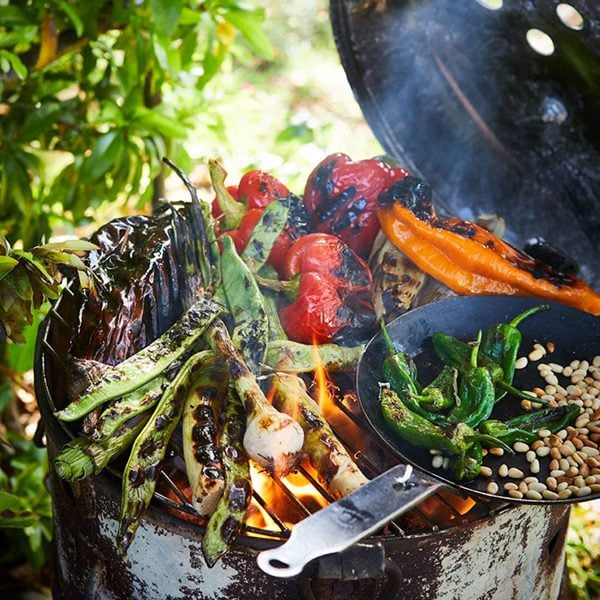
If you’re barbecuing anything that’s boneless and no more than about 3-4cm thick, you can cook it directly over the heat source (charcoal or gas).
If you are cooking something with a bone in, such as thick-cut joints, cook them indirectly, so they’re not immediately over the heat.
Adjusting the heat
- In a charcoal barbecue, move hot coals to the sides and cook in the middle of the grill. If your barbecue lets you adjust the distance between the grill and the coals, and/or has vents to control the amount of oxygen fuelling the fire, you have even more control over the heat level.
- On a gas grill, get the barbecue up to full heat, then turn off the burners directly underneath the meat. In both cases, keep the lid on at all times.
- Indirect cooking can take longer – if you’re roasting a large piece of meat, you’ll need to add more charcoal each hour to maintain a constant roasting temperature
- Place a foil tray, in between the coals, under the meat to catch the fat and juices when cooking indirectly. This will prevent the fat causing flare-ups, plus the drippings can be used for sauces and gravies.
Barbecue tips and hints
- Make sure charcoal and gas grills are up to temperature before cooking.
- Grilling times in charts and recipes vary depending on the amount, size and shape of food – and even the weather. Allow a little more cooking time on colder days.
- Trim excess fat from steaks, chops and roasts – this helps avoid flare-ups.
- Soak wooden skewers in cold water for at least 30 minutes before using them.
- If your cooking grate is crowded with food, cook for longer than the specified time.
- Make sure that individual pieces of food do not touch, so the food cooks on all sides.
- Because food cooked in a kettle barbecue is out of sight, it can be out of mind. Use a kitchen timer to remind you when to turn the food and when to take it off the heat.
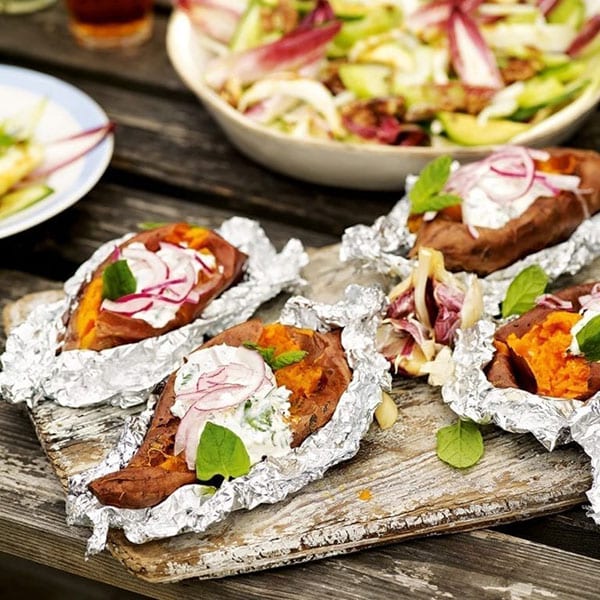
Troubleshooting
- Be patient with charcoal. It takes 30 minutes to reach cooking temperature.
- Avoid frequently turning or peeking at the food, as heat escapes when you open the lid. For direct cooking, turning the food halfway through the cooking time is usually sufficient.
- Keep the air vents at the top and bottom of a charcoal grill open while cooking.
- Don’t use a fork to pierce and turn small cuts of meat or all the juices will flow out.
- Many people think that grilling meat for a short time at a high temperature ‘seals in’ the juices. However, this just burns the meat on the outside, leaving it raw in the centre.
- For best results, sear meat for a few minutes over direct heat, then move it to indirect heat for the rest of the grilling time.
Safety guidelines
- Long-handed tools make the job easier and, more importantly, safer.
- Leave perishable foods in the fridge or a cool box until just before cooking.
- Use separate utensils such as chopping boards and plates for raw and cooked foods.
- Remember, stainless steel skewers will retain a lot of heat after cooking.
- Check hot coals are fully extinguished before leaving the barbecue site.
- Water and fire do not mix, and steam can cause burns. If flare-ups do occur, move the food to one side until the flames die down, and do not spray with water.
What is barbecue smoke?
Barbecue smoke is a combination of sooty particles, droplets of liquid and chemical vapours (mainly phenols). The latter are invisible, but are the key flavour elements. When these land on food, they stick to water or oil, reacting with proteins to create flavour and permeate the food.
Charcoal offers some smokiness, but for that aromatic smoked flavour you need specific types of wood. The simplest way to do this is to add some wood pellets or chips to your hot coals.
- Before use, soak chips/pellets in water for 20 minutes to stop them from burning too fast. A handful usually gives off enough smoke for 15 minutes, which is plenty – too much smoke can overpower the food.
- Different woods impart different flavours – oak and hickory are great all-rounders. You could also try mesquite (good with lamb and fish), maple (excellent with veg), apple (mild, good with chicken and white fish) or cherry (a connoisseurs’ favourite with pork ribs). Experiment and see what you like.
Find over 100 of our barbecue recipes here.
Subscribe to our magazine
Food stories, skills and tested recipes, straight to your door... Enjoy 5 issues for just £5 with our special introductory offer.
Subscribe
Unleash your inner chef
Looking for inspiration? Receive the latest recipes with our newsletter
